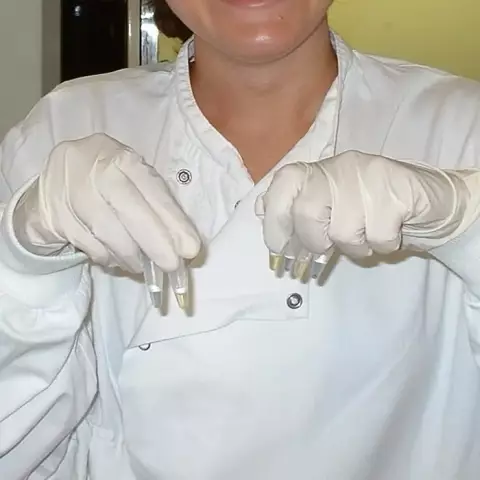- Author Curtis Blomfield [email protected].
- Public 2023-12-16 20:44.
- Last modified 2025-01-23 17:01.
The human brain can be called the central commanding organ. There are located not only the centers responsible for the understanding and reproduction of speech, the movement of the limbs, memory and processing of visual information. The brain contains in its structure a center for regulating the activity of blood vessels and the heart, the main thermoregulator, a site that controls breathing, and many other important areas. That is why this organ is so reliably protected: it is covered with three shells, between which liquid layers are located for shock absorption, and at the cellular level it is “guarded” by a barrier of cells.

What is serous meningitis?
If any of the microbes gets on one of the membranes of the brain and provokes its inflammatory changes, meningitis develops. The diseased tissue swells, blood circulation increases in it, aimed at helping it clear itself of infection faster. Cells of the immune system that are also involved inIn this process, they are actively released into the cerebrospinal fluid, which performs a shock-absorbing and supplying role for the brain and its membranes.
What is serous meningitis? This is when the analysis of liquor (that is, cerebrospinal fluid) contains more cells than normal (the norm for an adult is 10 cells per 1 microliter, for children a little more), while most of them are represented by lymphocytes. It is these cells of the immune system that are the first to participate in viral processes, and serous meningitis is almost always caused by viruses.
What is serous meningitis and what causes it?

The disease is caused by microbes that can overcome the cellular defenses that protect the brain. Mostly viruses:
- enteroviruses that are transmitted by airborne droplets, through kisses, when using thermally untreated water, milk, sour-milk and some other products;
- herpes simplex viruses that can get to a person in completely different ways: both by airborne droplets, and through sexual contact, and when the contents of a herpetic vesicle get on the skin or mucous membrane of another person, and from mother to child during pregnancy and childbirth;
- varicella-zoster, mumps, measles, rubella, adenoviruses "arriving" through the air from a sick person;
- viruses that can get bitten by ticks.
Serous meningitis incubation period in this case is from 2 to 14 days (on average 5-8), then usually develop symptoms inherent in many diseases(cough, fever, rash or diarrhoea) and then symptoms specific to meningitis appear.
Serous meningitis can also be caused by bacteria. These are a few microbes: tubercle bacillus, leptospira, rickettsia, listeria. Mushrooms, which can most often be the causative agents of meningitis in HIV infection, also cause serous meningitis.

What is serous meningitis and how does it present?
This disease often begins with manifestations of a viral disease: cough, runny nose, colds, measles, chicken pox, and so on. Then appear:
1) an increase in temperature to high (usually) numbers: this may be a “second wave” of hyperthermia (that is, before that the temperature has already returned to normal), or it may be a fever that has not stopped since the first days of the disease;
2) severe headache, which is aggravated by moving the head, when standing up, usually localized in the entire head;
3) nausea, vomiting, which may occur outside of food intake;
4) rash: as with chicken pox, measles, rubella, with enteroviral meningitis, small red spots appear abundantly all over the body;
5) photophobia;
6) lethargy, weakness, a person tries to lie down more;
7) increased skin sensitivity.
The case history of "Serous Meningitis" should cover all of these nuances:
- how the disease started;
- with what a person associates his appearance (hypothermia, contact withsick with a cold or diarrhea);
- what symptoms appeared later, was there a positive reaction to taking painkillers;
- objective symptoms that the doctor checks in order to justify the need for a lumbar puncture;
- quantity and quality of the cellular composition of CSF, protein, protein-sedimentary samples, cerebrospinal fluid electrolytes;
- biochemical blood tests;
- PCR study of CSF for the DNA of herpes simplex viruses, CMV, EBV;
- bacteriological examination of blood and cerebrospinal fluid;
- treatment;
- diaries for monitoring the dynamics of the course of diseases;
- a picture of the dynamics of changes in the CSF.






